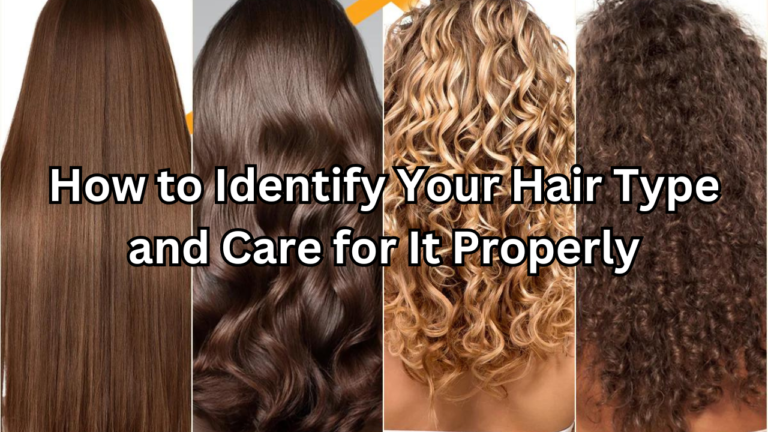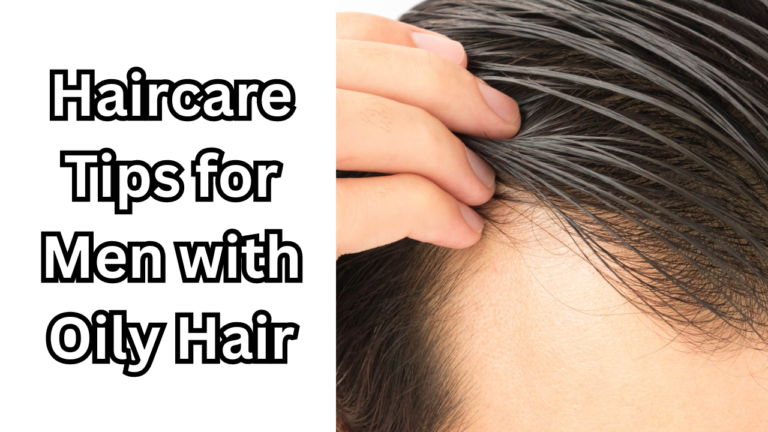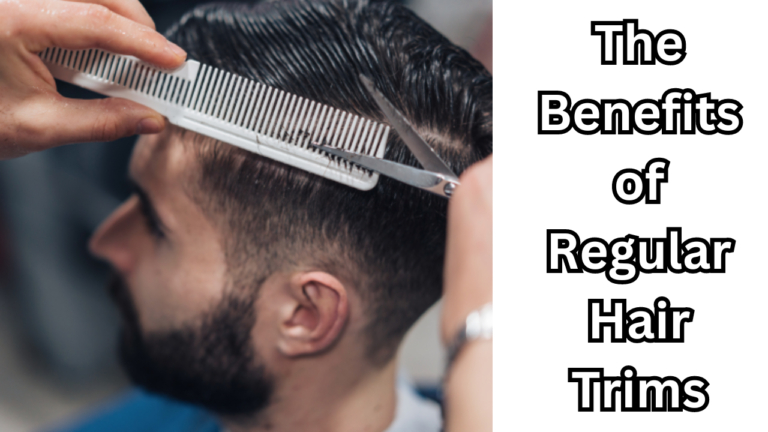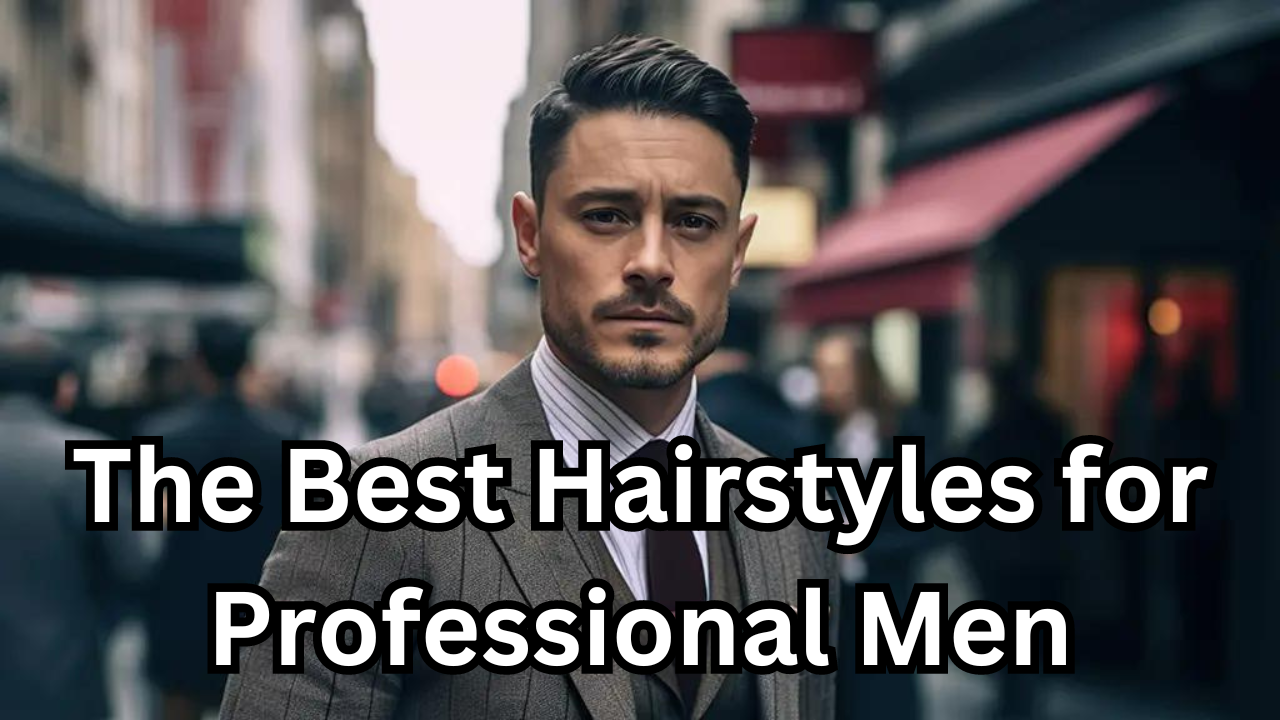
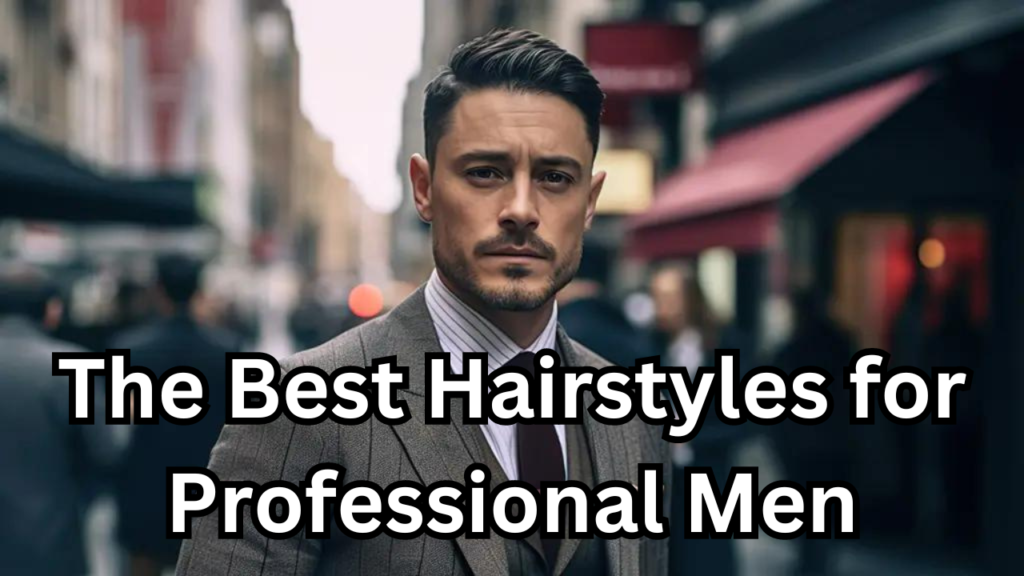
Table of Contents
Introduction
In today’s fast-paced professional world,hairstyles for professional men appearance often speaks louder than words. A well-chosen hairstyle can be a powerful asset, influencing how others perceive you and impacting your overall professional image. As workplaces evolve and dress codes become more flexible, the importance of a polished, appropriate hairstyle remains constant. It’s not just about following trends but about presenting yourself in a way that reflects confidence, competence, and respect for the professional environment.
Importance of a Hairstyles for Professional Men
A professional and a fashionable hairstyle is more than just a personal choice; it’s a statement of your professionalism and attention to detail. It demonstrates that you take your role seriously and are mindful of the norms and expectations of your industry. A well-groomed appearance can enhance your credibility, contribute to a positive work environment, and even open doors to new opportunities. In many cases, a professional hairstyle can help you make a lasting impression, showcasing that you are both polished and ready for the challenges of the business world.
How Hairstyles Impact First Impressions
First impressions are crucial, especially in professional settings where they can influence perceptions of your competence and reliability. Your hairstyle is often one of the first aspects of your appearance that others notice, making it a key component in shaping how you are perceived. A hairstyle that is clean, well-maintained, and appropriately styled can convey confidence and attention to detail, while a disheveled or outdated look might suggest a lack of professionalism or concern. By choosing a hairstyle that aligns with your professional environment and personal style, you can ensure that your first impression is a positive one, setting the tone for successful interactions and relationships in your career.
Classic Cuts
The Crew Cut
Description and Versatility
The crew cut is a timeless, no-fuss hairstyle characterized by short sides and back with slightly longer hair on top. This style offers a clean, well-groomed appearance that is easy to maintain and highly versatile. The length on top can be adjusted to suit personal preferences, whether you prefer a more uniform look or a bit of texture. Its simplicity allows for quick styling, making it an excellent choice for busy professionals who value both efficiency and appearance.
Best For Which Face Shapes and Hair Types
The crew cut is remarkably adaptable and works well with a variety of face shapes and hair types. It is particularly flattering for those with:
- Oval Faces: This cut complements the balanced proportions of an oval face, enhancing its symmetry.
- Square Faces: The crew cut softens the strong angles of a square face, providing a balanced, polished look.
- Round Faces: By keeping the sides short and allowing a bit of length on top, the crew cut can help elongate the appearance of a round face.
In terms of hair types, the crew cut is suitable for straight, wavy, and even slightly curly hair. It helps manage unruly locks while maintaining a sleek, professional appearance.
The Ivy League Cut
Key Features and Maintenance
Hairstyles for Professional Men, an evolution of the classic crew cut, features a bit more length on top, which allows for greater styling flexibility. The hair is typically cut short on the sides and back, with the top left longer to be styled with a side part or a slight quiff. This cut is known for its polished and sophisticated look, making it ideal for professional environments.
Key Features:
- Longer Top: Provides the option to style with a part or to add subtle volume.
- Short Sides and Back: Maintains a clean and neat appearance.
- Versatile Styling: Can be worn with a side part for a traditional look or styled back for a more contemporary edge.
Maintenance: The Ivy League cut requires regular trims to keep the top at an optimal length and to ensure the sides remain clean and well-defined. A bit of pomade or styling gel can help in achieving a well-maintained look throughout the day.
How It Suits Different Professional Environments
The Ivy League cut is highly versatile, making it suitable for a range of professional settings:
- Corporate Environments: Its clean lines and classic styling make it a great fit for formal office settings where a polished appearance is essential.
- Creative Industries: The additional length on top allows for some individuality and creative styling, which can be advantageous in more dynamic work environments.
- Business Casual Settings: The Ivy League cut offers a blend of sophistication and approachability, making it appropriate for environments with a relaxed dress code.
Overall, the Ivy League cut strikes a perfect balance between formality and modern style, making it a reliable choice for professionals across various fields.
Timeless Styles
The Side Part
Variations and Styling Tips
The side part is a classic hairstyle that has stood the test of time due to its versatility and sophisticated appearance. This style involves creating a distinct part in the hair, which is then styled to one side, with the sides and back kept shorter.
Variations:
- Classic Side Part: Hair is parted deeply to one side with a clean, defined line. The sides and back are cut short to enhance the structured look.
- Textured Side Part: Adds a bit of texture and volume to the top while maintaining a side part. This variation provides a more modern, relaxed appearance.
- Side Part with Fade: Combines a side part with a taper or fade on the sides and back, offering a contemporary twist on the classic style.
Styling Tips:
- Use a Comb: For a sharp and defined part, use a comb to create and maintain the parting line.
- Apply Product: Use a lightweight styling product like pomade or gel to keep the hair in place without making it look greasy.
- Regular Trims: To maintain the clean lines and overall shape, regular trims are essential.
Ideal for Business Settings
The side part is particularly well-suited for business settings due to its polished and professional look. It provides a sophisticated appearance that aligns with traditional office environments and formal business occasions. Its adaptability also makes it a good choice for men who want a classic style with a touch of modern flair, ensuring that it fits seamlessly into various professional scenarios.
The Taper Fade
Explanation of the Fade and Taper
The taper fade is a hairstyle characterized by a gradual transition in length from the top of the head down to the sides and back. This technique involves cutting the hair shorter as it moves toward the hairline, creating a smooth and blended effect.
Fade: The fade refers to the gradual shortening of hair length. It can be a low fade (starting near the ears), mid fade (starting at the temple), or high fade (starting near the top of the head), depending on the desired look.
Taper: The taper is a more subtle version of the fade, where the hair gradually shortens but doesn’t involve as stark a contrast. It blends seamlessly into the shorter length, creating a more understated transition.
Suitable Face Shapes and Hair Types
Face Shapes:
- Oval Faces: The taper fade complements the natural symmetry of an oval face, providing a balanced look.
- Square Faces: The fade softens the strong angles of a square face, offering a more rounded appearance.
- Round Faces: A taper fade can help elongate a round face by adding structure and creating the illusion of a more angular shape.
Hair Types:
- Straight Hair: The taper fade works well with straight hair, providing a clean, sharp look.
- Wavy Hair: This style can also be adapted for wavy hair, allowing for natural movement while maintaining a neat appearance.
- Curly Hair: For curly hair, a taper fade can help manage volume and maintain a structured shape, offering a stylish and controlled look.
The taper fade’s versatility makes it a popular choice for those seeking a contemporary, yet professional appearance that can be tailored to various face shapes and hair types.
Modern Professional Cuts
The Quiff
How to Achieve and Maintain the Look
The quiff is a stylish hairstyle that combines retro flair with a modern edge. Characterized by voluminous hair that is swept back and slightly upward, the quiff adds a sophisticated touch to any look. Achieving and maintaining a perfect quiff requires some attention to detail and the right techniques.
How to Achieve the Look:
- Start with Clean, Dry Hair: Begin with freshly washed and towel-dried hair. For best results, use a volumizing shampoo and conditioner.
- Apply a Pre-Styler: Use a lightweight mousse or volumizing spray to add body and hold to your hair.
- Blow-Dry: Use a blow dryer with a round brush to lift your hair at the roots and shape it into the desired quiff. Direct the airflow upward and backward for added volume.
- Style with Product: Apply a small amount of pomade or styling cream to your hair to define the quiff. For a stronger hold, opt for a strong-hold gel or wax.
- Shape and Finish: Use a comb to shape the quiff and ensure it’s even. Finish with a light hairspray for added hold without making the hair look stiff.
How to Maintain the Look:
- Regular Trims: Keep the sides and back trimmed to maintain the clean lines and prevent the quiff from looking too bulky.
- Re-styling: You may need to restyle your quiff throughout the day, especially if you’ve been in humid conditions. Keep a small amount of product handy for touch-ups.
Professional Settings Where It Works Best
The quiff can work well in a variety of professional settings, particularly those that allow for a bit of individuality and style:
- Creative Industries: Ideal for environments where a bit of flair is appreciated, such as in design, advertising, or media.
- Business Casual Offices: Suitable for workplaces with a relaxed dress code where a polished yet trendy look is acceptable.
- Client-Facing Roles: Adds a sophisticated edge that can be appealing in roles where first impressions are important, such as in sales or consulting.
The Pompadour
Styling and Volume Techniques
The pompadour is a bold and distinctive hairstyle that involves sweeping the hair back and up, creating a voluminous, eye-catching look. This classic style has been modernized to fit today’s professional standards.
Styling Techniques:
- Prepare Your Hair: Start with damp hair and apply a volumizing mousse or heat protectant spray to enhance volume and protect your hair from heat damage.
- Blow-Dry: Using a round brush and blow dryer, lift your hair at the roots and direct it backward and upward. Focus on creating height and volume at the front.
- Apply Styling Product: Use a strong-hold pomade or wax to shape and define the pompadour. Work the product through your hair, focusing on the front to maintain volume and structure.
- Shape the Pompadour: Use a comb or brush to refine the shape, ensuring it remains smooth and styled. For a sharper finish, use a small amount of hairspray.
Volume Techniques:
- Backcombing: Lightly backcomb the roots of your hair before blow-drying to add extra volume and lift.
- Root Lifting Products: Use root-lifting sprays or powders to add volume at the base of your hair, helping the pompadour maintain its shape.
Adaptations for a Professional Appearance
The pompadour can be adapted for a more professional look by adjusting its volume and shape:
- Subtle Volume: Opt for a less extreme volume if you’re aiming for a more conservative professional appearance. A moderate quiff can still provide a stylish edge without being too bold.
- Clean Lines: Ensure the sides and back are well-groomed and trimmed to avoid a disheveled appearance. A clean fade or taper can help balance the volume on top.
- Refined Finish: Keep the overall look neat and polished. Avoid excessive product use to prevent the style from looking too shiny or stiff.
By adjusting the volume and maintaining a well-groomed appearance, the pompadour can be an excellent choice for professionals seeking a hairstyle with both classic sophistication and modern flair.
Medium-Length Hairstyles
The Textured Crop
How to Add Texture and Volume
The textured crop is a versatile medium-length hairstyle characterized by its natural, tousled look. It incorporates layers and texture to add movement and volume, making it a stylish yet professional choice.
How to Add Texture and Volume:
- Start with Damp Hair: Begin with clean, damp hair. Use a volumizing or sea salt spray to create a foundation for texture.
- Blow-Dry with a Brush: Use a blow dryer and a round brush to lift the hair at the roots and enhance volume. Blow-dry in different directions to create natural movement.
- Apply Texturizing Product: Once hair is dry, apply a texturizing paste or clay to add definition and separation. Work the product through your hair with your fingers for a more natural look.
- Create Layers: If your hair isn’t already layered, consider getting a haircut that adds layers. This will help create depth and enhance the textured appearance.
Best Practices for a Clean, Professional Look:
- Keep It Neat: Ensure the sides and back are trimmed regularly to maintain a clean appearance. The top should have enough length to retain texture but not become unmanageable.
- Avoid Excess Product: Use a small amount of product to avoid a greasy or weighed-down look. Lightly apply and build up if needed.
- Regular Trims: Maintain the style by getting regular trims to keep the texture sharp and the overall look polished.
The Brush Up
Styling Techniques and Maintenance
The brush up is a medium-length hairstyle that features hair styled upward and slightly back, creating a voluminous, modern appearance. It combines a polished look with a bit of flair, suitable for various professional settings.
Styling Techniques:
- Start with Clean, Dry Hair: Wash and dry your hair. Use a volumizing mousse or spray to add body.
- Blow-Dry Upward: Blow-dry your hair while using a brush to lift it upward. Focus on creating height and volume at the front.
- Apply Styling Product: Use a lightweight pomade or styling cream to define the shape and hold the style in place. Avoid heavy products to prevent a greasy look.
- Finish with a Comb: Use a comb to smooth out any irregularities and refine the shape.
How to Keep It Neat and Professional:
- Regular Trims: Keep the sides and back trimmed to avoid a bulky or unkempt appearance. Regular trims will help maintain the shape and volume.
- Control Volume: Adjust the amount of product you use to control the volume and ensure it remains professional. Too much volume can make the style look less polished.
- Daily Maintenance: Use a light touch-up with a comb or brush to maintain the shape throughout the day. Carry a small amount of product for quick fixes if needed.
Hair Styling Tips
Using the Right Products
Recommendations for Different Hair Types:
- Straight Hair: Use a lightweight mousse or volumizing spray to add body. For a clean, controlled look, opt for a light pomade or styling cream.
- Wavy Hair: Choose a sea salt spray or texturizing cream to enhance natural waves and add volume. Light gels can also help define waves without weighing them down.
- Curly Hair: Use curl-enhancing creams or styling gels to define curls and control frizz. A small amount of styling gel can help maintain shape and volume.
Avoiding Overuse and Buildup:
- Apply Sparingly: Use a minimal amount of product to avoid buildup. Start with a small amount and add more if needed.
- Wash Regularly: Cleanse your hair regularly to remove product residue and prevent buildup. Use a clarifying shampoo occasionally to thoroughly cleanse your scalp and hair.
- Alternate Products: Consider rotating different products to avoid overuse of a single type, which can lead to buildup and dull hair.
Regular Maintenance
Importance of Trims and Haircuts:
- Maintains Shape: Regular trims help keep your hairstyle looking fresh and well-groomed. They prevent split ends and ensure that your style maintains its intended shape.
- Promotes Healthy Hair: Regular haircuts prevent damage and promote healthy growth, ensuring your hair remains in good condition.
How Often to Visit the Barber:
- Every 4-6 Weeks: For medium-length styles, visiting the barber every 4-6 weeks is generally recommended to maintain shape and avoid overgrowth.
- Adjust Based on Growth: If your hair grows quickly or if you prefer a very precise style, you might need to visit more frequently. Conversely, if you prefer a more relaxed style, you might extend the time between visits.
By following these tips and maintaining a regular grooming routine, you can ensure that your medium-length hairstyle remains sharp, professional, and stylish.
Haircare for Professional Men
Daily Routine
Basic Grooming and Care Tips:
- Cleanse Regularly: Use a mild shampoo suited to your hair type. For daily use, choose a gentle formula that cleanses without stripping natural oils.
- Condition Appropriately: Apply conditioner to the ends of your hair to maintain moisture and prevent dryness. If you have oily hair, consider a lightweight conditioner.
- Dry Gently: Pat your hair dry with a towel rather than rubbing it vigorously. This reduces breakage and helps maintain the health of your hair.
- Comb or Brush: Use a wide-toothed comb or a brush with soft bristles to detangle your hair. Start from the ends and work your way up to minimize damage.
Products to Use for Maintaining a Professional Look:
- Shampoo and Conditioner: Choose products formulated for your specific hair type (e.g., volumizing for fine hair, moisturizing for dry hair).
- Styling Products: Use lightweight pomades, gels, or creams that offer control without excess shine or stiffness. For a natural look, opt for matte products.
- Hair Treatments: Incorporate occasional treatments like leave-in conditioners or hair masks to address specific needs, such as moisture or repair.
Dealing with Common Issues
Managing Dandruff, Oily Hair, and Thinning Hair:
- Dandruff: Use a medicated anti-dandruff shampoo containing ingredients like ketoconazole or zinc pyrithione. Ensure you follow the instructions for effective treatment.
- Oily Hair: Opt for a clarifying shampoo that helps control excess oil. Avoid over-washing, which can lead to increased oil production. Dry shampoos can also be used between washes to absorb excess oil.
- Thinning Hair: Use thickening shampoos and conditioners designed to add volume. Consider styling products that provide a fuller appearance. In some cases, consulting with a dermatologist may be necessary for treatment options.
Adapting Hairstyles for Different Work Environments
Corporate vs. Creative Fields
How to Adjust Your Hairstyle Based on Industry Norms:
- Corporate Settings: Choose classic, conservative styles that maintain a polished appearance. Opt for hairstyles that are neat and well-groomed, such as the crew cut, side part, or Ivy League cut.
- Creative Fields: You have more flexibility to experiment with modern or textured styles. Consider hairstyles like the quiff or textured crop that allow for individuality while maintaining a professional look.
Remote Work Considerations
Balancing Professionalism with Comfort:
- Comfortable Styles: While working remotely, you might prioritize comfort. Choose hairstyles that are easy to maintain and do not require constant attention.
- Maintaining Professionalism: Even if you’re not in the office, keep your hairstyle tidy and well-groomed. This helps in maintaining a professional mindset and can be beneficial for video calls.
Consulting with a Stylist
Finding the Right Barber or Stylist:
How to Choose Someone Who Understands Professional Looks:
- Research and Recommendations: Look for stylists with experience in creating professional, polished looks. Personal recommendations or online reviews can guide you to skilled professionals.
- Portfolio Review: Check their portfolio for examples of professional styles they’ve created. This can give you an idea of their expertise and suitability for your needs.
Discussing Your Needs and Preferences:
- Be Specific: Clearly communicate your desired outcome, including any preferences or concerns about your hairstyle.
- Consultation: Schedule a consultation to discuss your hair type, face shape, and professional requirements. A good stylist will provide suggestions based on your specific needs.
Hairstyles to Avoid
Trendy Cuts That May Not Suit Everyone:
- Examples of Styles That Might Not Work in a Professional Setting: Avoid overly dramatic styles such as extreme fades, avant-garde cuts, or brightly colored hair. These can be perceived as too casual or unconventional in traditional professional environments.
Excessive Grooming Trends:
- Why Some Styles May Be Considered Too Casual or Unconventional: Styles that require excessive grooming or frequent touch-ups may not be practical for a professional setting. Choose a look that is manageable and fits seamlessly with your daily routine.
Maintaining Your Professional Image
Consistency in Appearance:
The Role of a Regular Hairstyle in Maintaining a Professional Image:
- Professionalism: Consistency in your hairstyle helps reinforce your professional image. A well-maintained, consistent look supports a sense of reliability and attention to detail.
- Recognition: Having a regular hairstyle also makes you easily recognizable, which can be advantageous in networking and professional interactions.
Keeping Your Hair Healthy:
Long-Term Haircare Tips for Sustaining a Professional Look:
- Healthy Diet: Haircare Tips like Maintain a balanced diet rich in vitamins and minerals to support healthy hair growth.
- Avoid Heat Damage: Limit the use of heat styling tools and always use a heat protectant if necessary.
- Regular Trims: Get regular haircuts to prevent split ends and maintain the shape of your hairstyle.
Seasonal Considerations
Adjusting Your Hairstyle for Weather Changes:
How to Adapt Your Style for Different Seasons and Climates:
- Winter: Use hydrating shampoos and conditioners to combat dryness. Consider styles that keep hair manageable and protected from cold weather.
- Summer: Choose lightweight products and styles that can withstand humidity and sun exposure. Consider using UV protection sprays for your hair.
Seasonal Haircare Tips:
- Protecting Your Hair During Extreme Weather Conditions: In extreme cold, wear a hat to protect your hair from wind and cold temperatures. In hot weather, use products that protect against UV rays and prevent sun damage.
By following these guidelines, professional men can maintain a well-groomed, versatile hairstyle that suits their work environment and personal style, while keeping their hair healthy and manageable throughout the year.
Conclusion
Hairstyles for Professional Men, choosing the right hairstyle is an essential aspect of maintaining a professional image. From classic cuts like the crew cut and Ivy League to modern styles such as the quiff and textured crop, each hairstyle offers unique benefits and can be adapted to fit various professional environments. Key to a successful professional appearance is selecting a style that not only aligns with industry norms but also complements your personal style. Effective haircare practices, such as regular trims, appropriate product use, and adapting to seasonal changes, further enhance your overall look. Ultimately, the best hairstyle is one that strikes a balance between personal preference and professional requirements, ensuring you present yourself with confidence and sophistication in any work setting. Embrace a style that reflects both your individuality and your commitment to professionalism, and you’ll find it seamlessly integrates into your daily routine, boosting your confidence and leaving a lasting impression.
